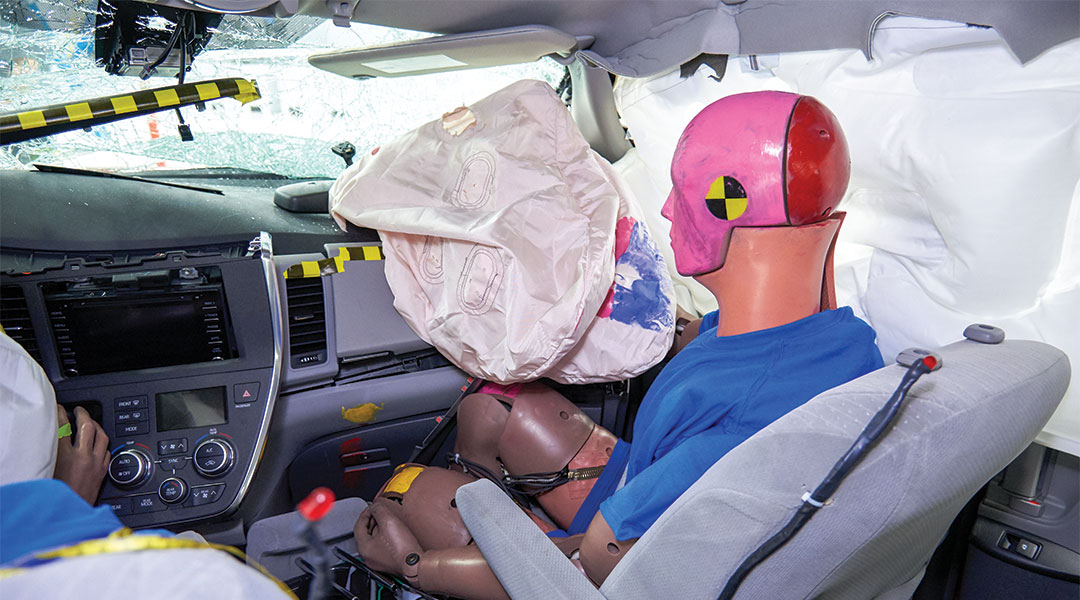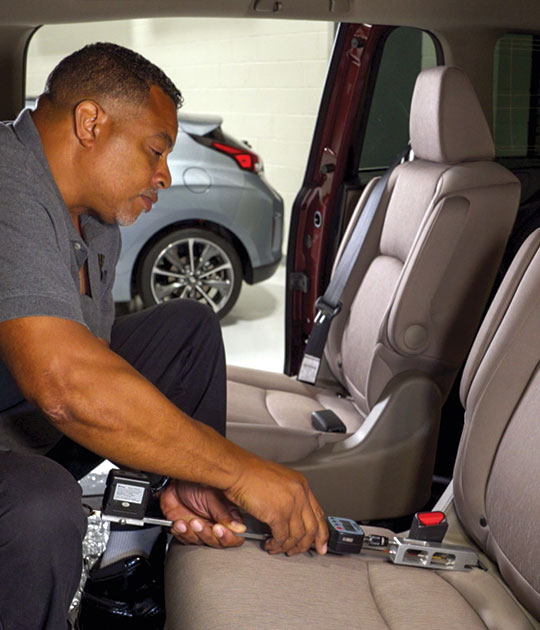The Toyota Sienna stumbled, the Chrysler Pacifica turned in an acceptable performance and the Honda Odyssey finished strong in the Institute’s passenger-side small overlap front crash test.
The 2018–19 model minivans are the latest group to be put through the passenger-side small overlap test. A small overlap crash occurs when just the front corner of the vehicle strikes another vehicle or an object such as a tree or utility pole. IIHS began rating vehicles for occupant protection in a driver-side small overlap front crash in 2012 and added the passenger-side test last year to make sure occupants on both sides of the vehicle get equal protection.
Manufacturers are making fast improvements to secure a good or acceptable rating in the passenger-side test, one of the requirements to earn a 2018 TOP SAFETY PICK+ award.
“In our latest passenger-side tests, we didn’t find any performance issues with safety belts or airbags like we did when we evaluated small and midsize SUVs earlier this year and midsize cars last year,” says David Zuby, the Institute’s chief research officer. “Instead, we saw some structural deficiencies on the right side that still need addressing.”
The Pacifica earns an acceptable rating in the passenger-side small overlap front test, and the Odyssey earns a good rating. Results for the Odyssey first were released in September 2017. The Sienna earns a marginal rating in the passenger-side small overlap test.
Small overlap front crash test ratings for 2018-19 model minivans
| PASSENGER-SIDE RATINGS | ||||||||
|---|---|---|---|---|---|---|---|---|
| Passenger injury measures | ||||||||
| DRIVER-SIDE OVERALL RATING | Overall | Structure | Passenger restraints & kinematics | Head & neck | Chest | Hip & thigh | Lower leg & foot | |
 Honda Odyssey |
||||||||
 Chrysler Pacifica |
||||||||
| Toyota Sienna | ||||||||
| GOOD | ACCEPTABLE | MARGINAL | POOR |
Safety cage shortcomings
Starting with 2015 models, Toyota modified the structure of the Sienna to improve driver-side protection but didn’t make the same changes to the passenger side. As a result, the Sienna’s structure rates poor in the passenger-side test.
“A safety cage must be strong enough to resist intrusion in a crash to protect the people inside, no matter where they sit in the vehicle,” Zuby says.
In the Sienna’s case, the structure allowed as much as 20 inches of intrusion in the lower occupant compartment and more than 16 inches of intrusion at the dashboard.
“The intruding structure crumpled around the test dummy’s legs. A real right front passenger would sustain possible injuries to the right hip and lower leg in a crash of this severity,” Zuby says.
Intrusion also was an issue for the Pacifica. Marginal ratings for structure held this minivan back from achieving the top rating in the passenger-side small overlap test. Measures from dummy sensors indicated low risk of injury, helping to offset the less-than-stellar structural rating.

Toyota Sienna

Honda Odyssey
A strong safety cage resists intrusion in a crash to protect occupants. The Sienna rates poor for structure in the passenger-side test due to as much as 20 inches of intrusion into the lower occupant compartment. In the Odyssey, the occupant compartment held up reasonably well to earn an acceptable rating for structure.

The Sienna’s airbags cushioned the dummy’s head, but the dashboard pushed against its knees in the test.
Fiat Chrysler introduced the Pacifica in the 2017 model year to replace the Chrysler Town & Country and upgraded protection in small overlap front crashes on both the driver and passenger sides, beginning with 2017 models built after August 2016.
The Pacifica’s passenger-side rating is based on two crash tests, one by IIHS and the other by Fiat Chrysler as part of the IIHS frontal crash test verification program.
The Pacifica and Odyssey are 2018 TOP SAFETY PICKs. They were among the qualifiers when IIHS announced initial winners of the 2018 awards in December 2017. Both earn a superior rating for front crash prevention and have acceptable-rated headlights. Better headlights would have secured TOP SAFETY PICK+ awards for these minivans.
To earn a 2018 TOP SAFETY PICK, a vehicle must have good ratings in all IIHS crashworthiness tests except the passenger-side test. Other requirements are a front crash prevention system that earns an advanced or superior rating and headlights that earn an acceptable or good rating.
To qualify for TOP SAFETY PICK+, a vehicle also must earn an acceptable or good rating in the passenger-side small overlap front test and a good headlight rating.
LATCH ratings
“Since minivans often serve as family haulers, parents in the market for a new one also should keep in mind where their kids will sit, especially if more than one needs a child restraint,” Zuby says.
Lower Anchors and Tethers for Children (LATCH) is a system of attachment hardware for child restraints that is intended to simplify installation. Child restraints installed with LATCH are more likely to be put in correctly than restraints installed using the vehicle safety belt, IIHS research has shown.
Even with LATCH, installation errors are common. The Institute’s LATCH ratings are based on key ease-of-use criteria that have been shown to minimize mistakes in installing lower attachment straps and top tethers. The top tether keeps the child seat from pitching forward in a crash, and all forward-facing restraints need them.
Among 2018 minivans evaluated, the Odyssey earns a good+ rating for LATCH ease of use. The Dodge Grand Caravan, Kia Sedona and Sienna rate acceptable, and the Pacifica rates marginal.
The good+ rating is for vehicles that meet the criteria for a good rating and provide additional seating positions with easy-to-use LATCH hardware.
Minivans and other three-row vehicles must have a third additional good or acceptable LATCH seating position (without “borrowing” an anchor from another position) and tether anchors in all rear seating positions to earn a good+ rating. The additional tether anchors must meet at least 1 of 2 tether anchor criteria. If the vehicle has a second-row center seating position, it must have good or acceptable LATCH there (with or without borrowing).
The good+ designation is intended to encourage manufacturers to give parents greater flexibility when seating children in a vehicle.

An IIHS engineer measures a second-row seat in the Honda Odyssey as part of the LATCH rating program.
How 2018-19 minivans
rate for LATCH
| GOOD+ |
|---|
| Honda Odyssey |
| ACCEPTABLE |
| Dodge Grand Caravan |
| Kia Sedona |
| Toyota Sienna |
| MARGINAL |
| Chrysler Pacifica |
“The Odyssey is a good example of the steady improvements we have seen in LATCH ratings in just three years,” Zuby says. “Honda factored in LATCH when redesigning the Odyssey for 2018, boosting the minivan’s rating from acceptable to good+ by making the second-row tether anchors easy to find and the lower anchors easy to maneuver around. In addition, the Odyssey model we tested has two good LATCH seating positions in the second row and two acceptable positions in the third row.”
The LATCH ratings are an indicator of how easy it is to achieve a correct, tight installation of a child restraint in a given vehicle when using the dedicated child restraint attachment hardware. While child restraints need to be properly installed, the LATCH rating doesn’t have any direct bearing on safety. Although it is difficult to achieve a good installation in a poor-rated vehicle, it is generally not impossible. In addition, children are just as safe in restraints that have been properly installed with vehicle belts as in restraints that have been properly installed with LATCH.
